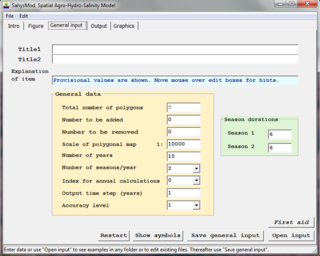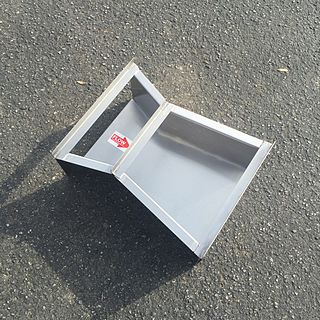Related Research Articles

Pressure is the force applied perpendicular to the surface of an object per unit area over which that force is distributed. Gauge pressure is the pressure relative to the ambient pressure.

In statistics, the standard deviation is a measure of the amount of variation or dispersion of a set of values. A low standard deviation indicates that the values tend to be close to the mean of the set, while a high standard deviation indicates that the values are spread out over a wider range.

Irrigation is the agricultural process of applying controlled amounts of water to land to assist in the production of crops, as well as to grow landscape plants and lawns, where it may be known as watering. Agriculture that does not use irrigation but instead relies only on direct rainfall is referred to as rain-fed. Irrigation has been a central feature of agriculture for over 5,000 years and has been developed independently by many cultures across the globe.

Evapotranspiration (ET) is a term used to refer to the combined processes by which water moves from the earth’s surface into the atmosphere. It covers both water evaporation and transpiration. Evapotranspiration is an important part of the local water cycle and climate, as well as measurement of it plays a key role in agricultural irrigation and water resource management.

The standard error (SE) of a statistic is the standard deviation of its sampling distribution or an estimate of that standard deviation. If the statistic is the sample mean, it is called the standard error of the mean (SEM).
Irrigation scheduling is the process used by irrigation system managers to determine the correct frequency and duration of watering.
Drip irrigation or trickle irrigation is a type of micro-irrigation system that has the potential to save water and nutrients by allowing water to drip slowly to the roots of plants, either from above the soil surface or buried below the surface. The goal is to place water directly into the root zone and minimize evaporation. Drip irrigation systems distribute water through a network of valves, pipes, tubing, and emitters. Depending on how well designed, installed, maintained, and operated it is, a drip irrigation system can be more efficient than other types of irrigation systems, such as surface irrigation or sprinkler irrigation.
In statistics, a contingency table is a type of table in a matrix format that displays the (multivariate) frequency distribution of the variables. They are heavily used in survey research, business intelligence, engineering, and scientific research. They provide a basic picture of the interrelation between two variables and can help find interactions between them. The term contingency table was first used by Karl Pearson in "On the Theory of Contingency and Its Relation to Association and Normal Correlation", part of the Drapers' Company Research Memoirs Biometric Series I published in 1904.
In probability theory and statistics, the coefficient of variation (CV), also known as relative standard deviation (RSD), is a standardized measure of dispersion of a probability distribution or frequency distribution. It is often expressed as a percentage, and is defined as the ratio of the standard deviation to the mean . The CV or RSD is widely used in analytical chemistry to express the precision and repeatability of an assay. It is also commonly used in fields such as engineering or physics when doing quality assurance studies and ANOVA gauge R&R, by economists and investors in economic models, and in neuroscience.

An air flow bench is a device used for testing the internal aerodynamic qualities of an engine component and is related to the more familiar wind tunnel.
The root-mean-square deviation (RMSD) or root-mean-square error (RMSE) is a frequently used measure of the differences between values predicted by a model or an estimator and the values observed. The RMSD represents the square root of the second sample moment of the differences between predicted values and observed values or the quadratic mean of these differences. These deviations are called residuals when the calculations are performed over the data sample that was used for estimation and are called errors when computed out-of-sample. The RMSD serves to aggregate the magnitudes of the errors in predictions for various data points into a single measure of predictive power. RMSD is a measure of accuracy, to compare forecasting errors of different models for a particular dataset and not between datasets, as it is scale-dependent.

In statistics, data transformation is the application of a deterministic mathematical function to each point in a data set—that is, each data point zi is replaced with the transformed value yi = f(zi), where f is a function. Transforms are usually applied so that the data appear to more closely meet the assumptions of a statistical inference procedure that is to be applied, or to improve the interpretability or appearance of graphs.

An impact sprinkler is a type of irrigation sprinkler in which the sprinkler head, driven in a circular motion by the force of the outgoing water, pivots on a bearing on top of its threaded attachment nut. Invented in 1933 by Orton Englehart, it quickly found widespread use. Though it has in many situations been replaced by gear-driven "rotor heads", many varieties of impact sprinkler remain in use.

Soil salinity control relates to controlling the problem of soil salinity and reclaiming salinized agricultural land. The aim of soil salinity control is to prevent soil degradation by salination and reclamation of already salty (saline) soils. Soil reclamation is also called soil improvement, rehabilitation, remediation, recuperation or amelioration.

SahysMod is a computer program for the prediction of the salinity of soil moisture, groundwater and drainage water, the depth of the watertable, and the drain discharge in irrigated agricultural lands, using different hydrogeologic and aquifer conditions, varying water management options, including the use of ground water for irrigation, and several crop rotation schedules, whereby the spatial variations are accounted for through a network of polygons.

SaltMod is computer program for the prediction of the salinity of soil moisture, groundwater and drainage water, the depth of the watertable, and the drain discharge (hydrology) in irrigated agricultural lands, using different (geo)hydrologic conditions, varying water management options, including the use of ground water for irrigation, and several cropping rotation schedules. The water management options include irrigation, drainage, and the use of subsurface drainage water from pipe drains, ditches or wells for irrigation.
Road surface textures are deviations from a planar and smooth surface, affecting the vehicle/tyre interaction. Pavement texture is divided into: microtexture with wavelengths from 0 mm to 0.5 millimetres (0.020 in), macrotexture with wavelengths from 0.5 millimetres (0.020 in) to 50 millimetres (2.0 in) and megatexture with wavelengths from 50 millimetres (2.0 in) to 500 millimetres (20 in).

Surface irrigation is where water is applied and distributed over the soil surface by gravity. It is by far the most common form of irrigation throughout the world and has been practiced in many areas virtually unchanged for thousands of years.

Micro-irrigation, also called Micro-spray,localized, low-volume, low-flow, or trickle irrigation, is an irrigation method with lower water pressure and flow than a traditional sprinkler system. Low-volume irrigation is used in agriculture for row crops, orchards, and vineyards. It is also used in horticulture in wholesale nurseries, in landscaping for civic, commercial, and private landscapes and gardens, and in the science and practice of restoration ecology and environmental remediation. The lower volume allows the water to be absorbed into slow-percolation soils such as clay, minimizing runoff.

The Cutthroat flume is a class of flow measurement flume developed during 1966/1967 that is used to measure the flow of surface waters, sewage flows, and industrial discharges. Like other flumes, the Cutthroat flume is a fixed hydraulic structure. Using vertical sidewalls throughout, the flume accelerates flow through a contraction of sidewalls until the flow reaches the "throat" of the flume, where the flow is then expanded. Unlike the Parshall flume, the Cutthroat flume lacks a parallel-walled throat section and maintains a flat floor throughout the flume.
References
- ↑ Burt, Charles M.; Styles, Stuart W. (1999). Drip and Micro Irrigation for Trees, Vines, and Row Crops (2nd ed.). San Luis Obispo, CA: Irrigation Training and Research Center (ITRC) - Cal Poly. pp. 13–26. ISBN 0-9643634-2-9.
- ↑ http://ufdcimages.uflib.ufl.edu/UF/00/00/85/33/00001/00010.pdf [ bare URL PDF ]